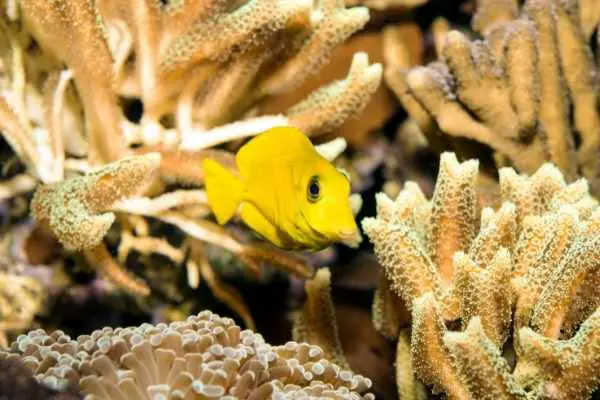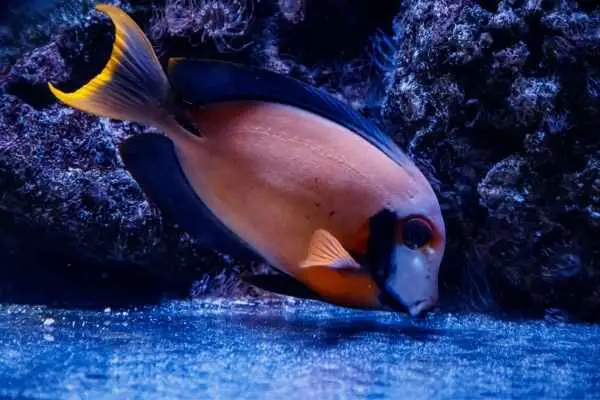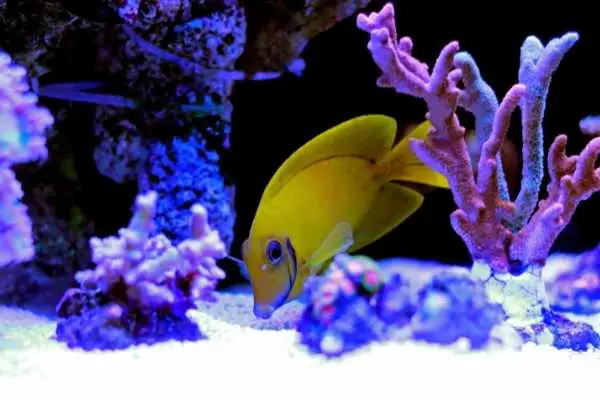The mimic tang (Acanthurus pyroferus) stands out from the crowd – well, by NOT standing out. No, really. One of the coolest aspects of this species is the ability to don the colors and patterns of local angelfish while they’re juveniles. The mimicry keeps them safe, sound, and thriving until they morph into the color of the adults. That’s when they adopt the brute behavior one expects from tangs. They’re a unique species that works regardless of what age fish you happen to pick.
Table of Contents: Mimic Tang Care
Not every mimic tang looks the same. The camouflage depends on the region they inhabit. Luckily, any of the options look stunning in a reef tank. But it’s helpful to know why one mimic tang looks completely different from another. That’s where reading through the links below can come in handy. (Or, you know, the entire article)
- Quick Facts
- Description of the Mimic Tang
- Mimic Tang Lifespan
- Creating the Ideal Mimic Tang World
- Mimic Tang Diet
- Mimic Tang Behavior and Tank Mates
- Breeding the Mimic Tang
- Pros and Cons
- For More Information

Quick Facts
- Common Names: Mimic tang, Mimic lemon peel tang, Mimic surgeon, Chocolate surgeonfish, Yellow mimic tang, Chocolate tang, Heraldi, Lemon peel tang, Half-back tang, Harold’s mimic tang, Black-barred tang, Orange-grilled surgeonfish, Pacific mimic surgeon, Yellow-spot surgeon
- Scientific Names: Acanthurus pyroferus
- Size: 8 inches (20.3cm)
- Minimum Tank Size: 125 Gallons (473L)
- Reef Safe? Yes
- Care or Experience Level: Easy
- Preferred Diet: Herbivore
- Original Part of the World: Indo-Pacific
Description of the Mimic Tang
So what does a mimic tang look like? It depends on a couple of variables. First, what region of the ocean are you looking in? The company the juvenile tangs keep sets the tone for their scales. (You need to know who the popular kids are before you start imitating them) Most hobbyists are familiar with the bright yellow version of the mimic tang. These youngsters fall in with crowds of lemon peel angelfish (Centropyge flavissimus). So the color scheme and round shape make sense. But it’s not the only option out there.
Around Palau, you won’t see many lemon peel angelfish. Instead, you find half-black or pearlscale angelfish (Centropyge vrolikii). That yellow shade doesn’t work anymore, so mimic tang juveniles in that area adopt a different look. They divide their bodies into a light front and dark back with gray spots on the fins. This allows them to hide out with the local schools of cool kids.

The same theory goes to work when you venture away from Guam and encounter schools of red-stripe or Eibl’s angelfish (Centropyge eibli). The mimic tang sports a cream base with orange stripes and a black tail. Three completely different looks, but all the same species. It’s known as Batesian mimicry, and it allows the juveniles to stay safe by donning the looks of the angelfish around them.
As mimic tangs mature, they lose their camouflage. Adults darken in color along the body, ranging from tan to nearly black. One dark band bisects the fish behind the gills, and you get a thin white chin strap. You’ll often see a few yellow highlights, especially around the eyes and fins. Some fish will also develop green highlights to their fins.
Put an adult next to the juvenile, though, and you likely wouldn’t suspect they were related.
Mimic Tang Lifespan
Mimic tangs – as you’ve probably already guessed – spread throughout the Indo-Pacific. You’ll find them popping up in coastal reefs and shallow lagoons. Of course, you might need to look closely at the schools swimming around the corals to pick out the juveniles from the angelfish they’re imitating. They hang out with the species they resemble for protection and access to the best feeding grounds.
Keeping tabs on these shape-shifters (well, color-shifters) isn’t the easiest. Depending on the variety of mimic tang, fish can lose stripes and other identifying patterns as they mature. As such, most of the lifespan information comes from captive records. With ideal care and management, you can expect your colorful tang to survive for around 8-10 years. (And since they’re brightest as juveniles, that’s when most hobbyists pick them up)
Creating the Ideal Mimic Tang World
Mimic tangs show up on the ocean slopes of reefs from Seychelles to the Marquesan and Tuamotu Islands, as far north as Japan, throughout the Community Islands, and down to the Great Barrier Reef and New Caledonia. Unfortunately, a lone individual also surfaced (as an introduced exotic) in Florida. Scientists believe the intruder came from a captive release, but the thriving presence caused some concern that the species could become invasive if the trend continues.
As the juveniles attach themselves to schools of pygmy angelfish, they swim throughout shallow lagoons and explore the safety of reef slopes. Once they mature and move out on their own, they venture down to 196 feet (60m). Mimic tangs stay close to the rocks and corals at the edge of the drop-off, enjoying the rough waters of the oceanic currents.

When setting up your saltwater aquarium, balancing between room to swim and hiding places is the key. Mimic tangs enjoy exploring and foraging for meals. But – especially as juveniles – they’re also on the shy side. Without a retreat, your fish will struggle with stress levels. You want to offer both options to keep your little imitator comfortable.
Live rock structures with crevices and caves will solve the “hideout” side of the equation. The various nooks and crannies will also offer territory for your tang to stake a claim over – once they mature. You can also break up the line of sight and allow additional sites for algae growth with rockwork. And, provided you keep the structures along the tank’s perimeter, it won’t interfere with the swimming space.
With open room to explore, you’ll get to enjoy the peaceful side of your mimic tang’s personality. You can also set up your powerheads or wavemakers to generate a healthy current through this zone. The fish enjoy boisterous water movement for exercise. It will keep them active and interested in the environment around them.
Mimic Tang Tank Size
Pygmy angelfish earn their name from the relatively unimpressive size the fish attain. And such aquarium sizes work for their duplicates – when the mimic tangs are juveniles and still growing into their fins. Once they start maturing, though, they reach an impressive 8 inches (20.3cm) in length. The tank you can get away with for housing these colorful “clones” won’t work once they start growing.
You’ll need a minimum of 125 gallons (473L) for an adult mimic tang. This will provide enough space for that open swimming room and the live rock. And, as you’ve probably guessed, that’s ONE tang. While mimic tangs aren’t as aggressive as some of their cousins, they still possess a mean streak as adults. You can’t get away with more than one in a tank at a time.
Are Mimic Tangs Reef-Safe?
Mimic tangs developed Batesian mimicry to protect themselves from predation and get at the best food on the reef without daily hassling (more on that in a minute). Luckily for you, that menu DOESN’T include coral polyps. They’re herbivores, leaning heavily on the macroalgae scale. And since corals and algae compete for the same resources? Mimic tangs work beautifully in reef tanks.
Of course, their preference for water turbulence may not be to every coral’s delight. You may want to look at your live rock and create safe little pockets for your more delicate coral species. But at least you know you don’t need to worry about your tang sampling any of the polyps.

Mimic Tang Diet
As with other tang species, mimics enjoy a menu heavy on plant life. A saltwater aquarium with a healthy growth of algae is the perfect option for these little imitators. Or you can supplement their daily fare with a refugium. If that’s not to your liking, a veggie clip with nori – freshened three times a week – will work as an adequate substitute.
If you don’t keep up with their green demand, you’ll see your tangs struggle. They won’t develop a robust immune system, which can lead to infections. You’ll also end up with a meaner-than-usual tang (if you can believe such a thing exists).
If you have other herbivores in your tank, your mimic tang WILL challenge them for the algae and other available veggies. It’s best if you have more than you think you’ll need. Then your tang will remain healthy, and you won’t have to cope with aggression issues.
That’s not to say you shouldn’t mix in SOME protein sources, though. No fish is 100% herbivore (or carnivore, for that matter). Mimic tangs are colorful fish, even as adults. So they need some of the nutrients in protein to keep their scales looking their best. Luckily, these tangs aren’t challenging to feed. Any frozen food will usually get accepted:
- Brine shrimp
- Krill
- Mysis shrimp
As mimic tangs remain active during daylight hours, expect to offer food at least three times a day. It’s the best way to meet their metabolic demands. If you try to cut back on feedings, your tang could end up OVEREATING. You don’t want to go down that road. And, again, you don’t want to run the risk of a hungry tang bullying other fish in the tank.
Mimic Tang Behavior and Tank Mates
Mimic tangs start tiny. And tiny fish? Yeah, they’re the perfect snack on a reef. So youngsters spend time hiding in caves and crevices between corals where it’s safe. But not much food reaches those spots. That’s where the Batesian mimicry comes in. Not only do the juveniles look like the angelfish, but they also ACT like them. This allows them to blend in with passing schools, gaining the protection of “safety in numbers.”
The mimicry goes a little further than that, though. Throughout the Indo-Pacific, you’ll find damselfish in the same areas as mimic tangs. The two have similar menus. Damselfish don’t like to share, though, and they’ll attack juvenile tangs to get them to leave an area. Angelfish aren’t as picky in their meal choices. And damselfish leave angelfish alone. So mimic tangs don scales and act like angelfish to avoid the bullying and get to the best food sources.
Once a mimic tang grows into that famous tang grouchiness, though, they can handle themselves. So they set the juvenile colors aside. That’s when they start moving about on their own. However, it’s common to see an adult tang pull up to a cleaning station. Cleaner wrasses help remove unwanted parasites from their scales.

In home aquariums, it’s tempting to replicate the wild environment. (After all, everything SOUNDS cool) But it’s a terrible idea to set up your mimic tang with ANY of the angelfish species they imitate. Once your tang matures, it’ll turn on those angelfish. Then you have to deal with aggression and the potential tank transfer of one of the species. You can appreciate the colors of the mimic tang without needing the “camouflage” around.
At the same time, you WANT cleaning stations. But cleaner wrasses are tricky for some hobbyists. As such, you may want to opt for neon gobies or cleaner shrimp. They’re less demanding in their care and maintenance needs.
As for tank mates, mimic tangs are unusual. You CAN keep them with other tangs – provided you follow a few restrictions. You want surgeonfish of around the same size. And they MUST go into your tank at the same time as the mimic. You’ll want to keep an eye on your fish to ensure no fighting breaks out (nothing’s set in stone regarding behavior). But mimic tangs are more tolerant of their cousins than other species.
Otherwise, this species does well with most reef fish. They can develop aggression when housed in tanks that are too small or feel crowded. And, of course, stress won’t help. You’ll want to offer enough hiding places AND room to swim to keep everyone happy.
Breeding the Mimic Tang
Mimic tang males and females look identical from the outside. That always sounds frustrating when you contemplate breeding a species in captivity. Of course, considering mimics have yet to be bred successfully in a home aquarium, you may be shooting for the stars.
Part of the problem is attempting to house two fish in the same tank. They’ll tolerate other tangs around. But two mimic tangs? You’re asking for trouble. (And don’t think the camouflage will fool them) Even impressively large aquariums haven’t managed the trick.
The other part of the equation is the broadcast spawning of the species. Mimic tangs release their gametes into the plankton to hatch and develop. That’s a difficult thing to replicate in a captive situation. In the wild, the male tang changes the color of his scales to attract a mate. He also performs a “shimmy” movement. Once paired up, the male and female swim toward the surface in double arcs, releasing the gametes at the apex.
Providing the space and conditions to replicate the scenario in the average tank is almost impossible. So, for now, mimic tangs undergo wild collection. It means the possibility of more varied colors for hobbyists, though that can increase their cost. And, of course, that means you may need to wait for one to become available.
Pros and Cons
Discussing the different appearances of mimic tangs never gets old. At least, not for science geeks. But deciding to bring one of these colorful camouflagers into your saltwater aquarium takes some careful thought. You want to make sure you check all of the boxes.
Pros
- Mimic tangs are hardy species, rarely developing marine ich – despite their wild collection.
- You don’t need to offer much more than live rock hiding places and open swimming space for your mimics.
- Mimic tangs enjoy frequenting cleaning stations, allowing you to watch this natural behavior.
Cons
- Mimic tangs WILL share a tank with other tang species their size, but they don’t tolerate sharing an aquarium with another mimic tang.
- It’s crucial to provide enough macroalgae in your mimic’s diet to provide a healthy immune system.
- Mimic tangs have yet to breed in a captive home aquarium, requiring continued wild collection.
For More Information
Everyone learns about Batesian mimicry when they’re in school. But how many people get to demonstrate it with their reef tank? Mimic tangs are the perfect science lesson brought to life. Plus, they’re gorgeous fish to look at. Do you even need more reasons than that to bring one home? Assuming you do, here’s more information about these little “hide in plain sight” species.
This YouTube video walks you through everything you need to know about mimic tangs:
Want to know about some of the best mimic tang tank mates?
Curious about which tangs you can keep with a mimic tang?
Want an idea of the best cleaner species to stock your tank with?
Conclusions
Mimic tangs have developed the best way to survive – and thrive – from infancy to adulthood. Simply hang out and blend in with the cool fish on the reef. It’s a unique evolutionary advantage. And one that’s granted them a vibrant set of scales. Even after they morph into adults, they’re still a sight to behold. You won’t regret taking a chance on one of these imitators.
References
- Allen, G., Steene, R., Humann, P., and Deloach, N. 2003. Reef Fish Identification: Tropical Pacific.
- Fatherree, J.W. 2009. “Aquarium Fish: Surgeonfishes, AKA the Tangs.” Advanced Aquarist.
- Fenner, B. “Surgeons, Tangs, and Doctorfishes: Family Acanthuridae.” Wet Web Media.
- Fenner, B. “The Tangs, Surgeons, Doctorfishes of the Genus Acanthurus: Part 1, Part 2.” Wet Web Media.
- Randall, J.E. 2005. Reef and Shore Fishes of the South Pacific.


Leave a Reply